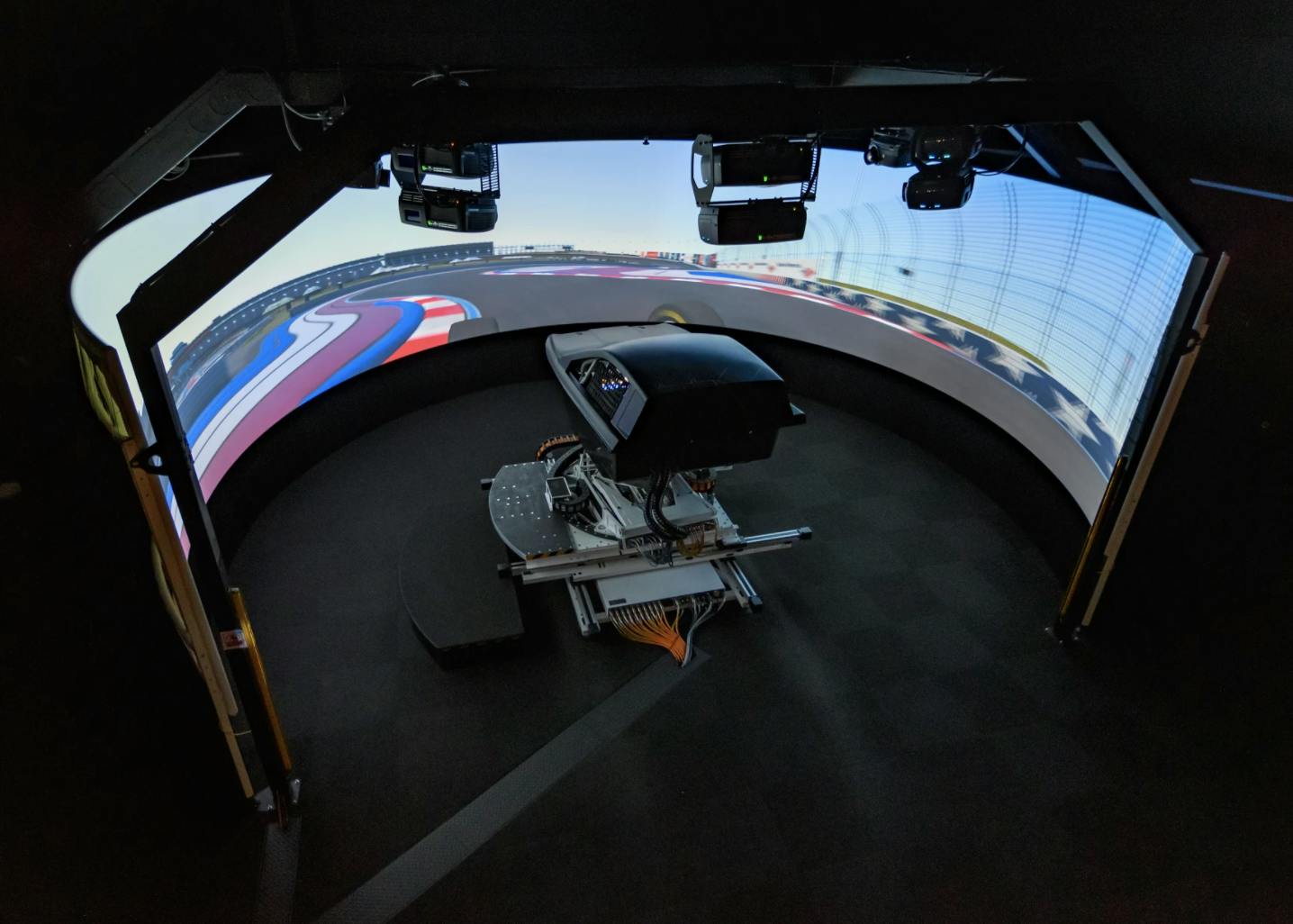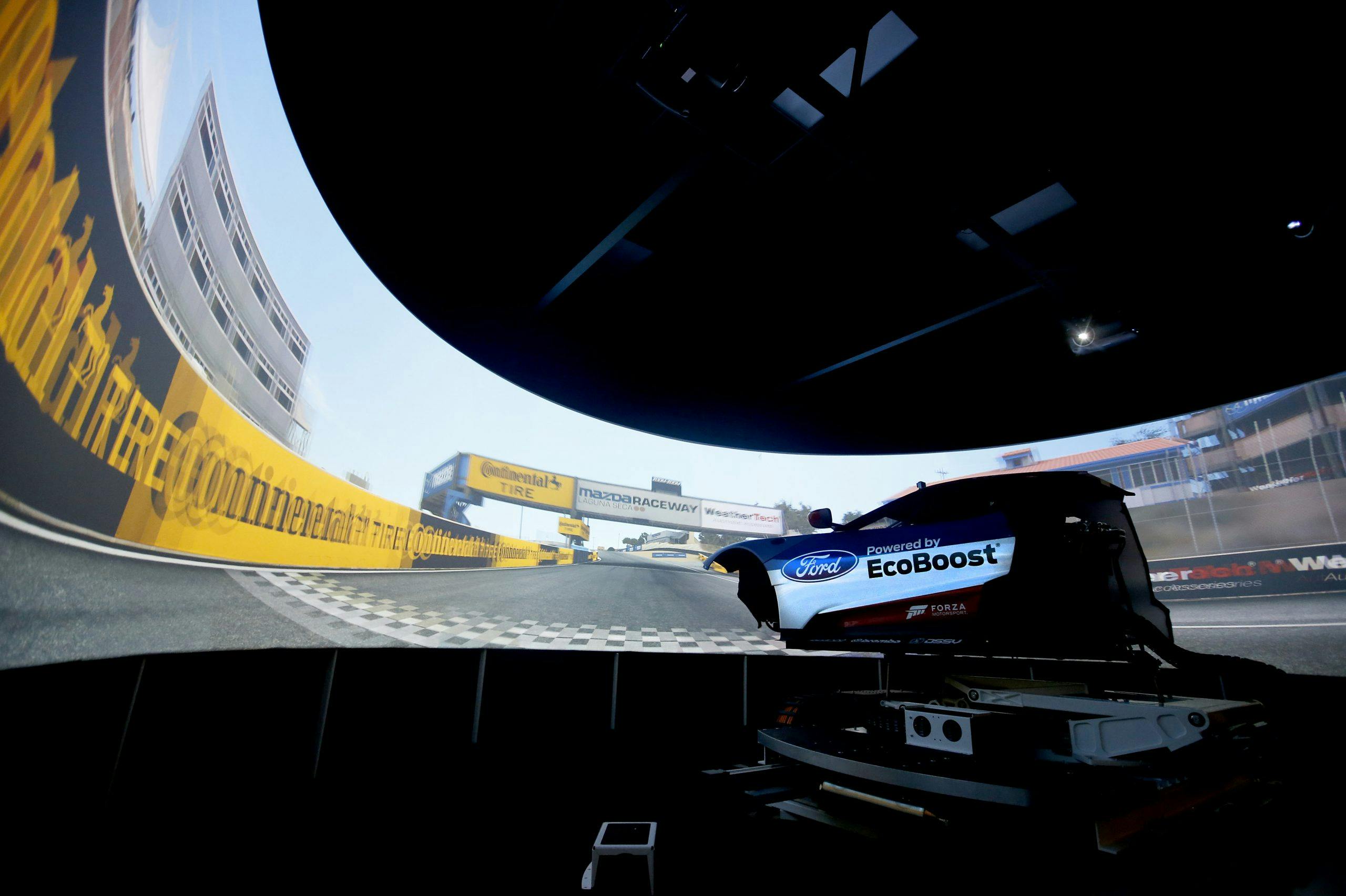Ford Performance has its own simulator, so why not build your own?
Just outside NASCAR’s capital of Charlotte, North Carolina, the world’s top race car drivers file in and out of a white warehouse shrouded in black glass. Some stay for hours, some for the day—most leave sweaty. This is the Ford Performance Technical Center. Constructed in 2014, the 33,000-square-foot facility houses computers and apparatus used to test Ford’s race cars and its race car drivers. Every day, around the clock, racers take turns sharing Ford’s two driving simulators.
This building houses only two simulators, but each stations replicates what it feels like to drive any of Ford’s current race cars on any track, anything from a NASCAR truck at Dover to an IMSA Mustang at Sebring.
A driver, let’s say Kevin Harvick, has his own racing seat. Ford installs his seat into a buck, or fuselage, that replicates the NASCAR star’s Mustang stock car from the hood to the B-pillar. No grille, no wheels, no back half of the car. This buck is lifted by something that looks like a giant engine hoist and placed on top of a machine that can pitch in all directions to mimic any scenario of on-track movement. A 12-foot-tall screen wraps 270 degrees around the rig. From the buck’s cockpit, Harvick can see only the screen. Thanks to this trick setup, he can drive an entire simulated race from inside the warehouse.
“The simulators are always in use,” says Ford’s NASCAR program supervisor, Pat DiMarco. “We start at the top with Cup Series teams and make sure they have what they need, then the Xfinity series, and then trucks.” Frequent simulator sessions aren’t simply a result of the mandated travel bans and health precautions; these session are an established part of modern, top-tier auto racing. When teams aren’t testing at actual tracks, drivers are turning laps virtually at their manufacturers’ multi-million-dollar test centers.
Don’t have the manufacturer backing, and still hankering to turn some simulated laps? We’ve compiled a list of simulator goodies below to consider for your own home-built setup.
Wheels and pedals
There are tons of options for wheels and pedals. If you’re looking for a budget wheel-and-pedal combo for an arcade-style driving game, you can snag the Thrustmaster T150 set for about $250. If you’re more sim-serious, purchase the Logitech G920 set for a little under $400. For a sharper feedback and increased resistance, you can always move up to something like Fanatec’s CSL Elite Wheel paired with its ClubSport pedals, which will ring in around $900. The ClubSport pedals are adjustable, and if you want, you can purchase the Brake Performance Kit with stronger springs for more realistic resistance. All of the aforementioned options have dual-clutch replicating paddles mounted on the steering wheel.
Shifter
Want to row your own gears? If you purchased a set of pedals with a clutch, then you can go manual hunting. Logitech offers a decent gated shifter (around $170), whereas Fanatec’s ClubSport Shifter is a more robust option and will run you about $250.
Seat and rig
If you have some two-by-fours and a bucket seat, you can make a rig on the cheap. If you’d prefer to go the store-bought route, Rseat’s RS1 can be yours for less than a grand. The more rigid the structure, the more it will set you back. If you want something that moves like the Ford simulator, you’ll have to fork over thousands. Next Level Racing’s Motion Platform V3 can toss you around pretty well, and at $3000, it’s one of the cheapest options out there.
Software/console
As with the hardware components, you have plenty of choices here. Will you focus more on sims such as iRacing, or do you prefer a more laidback driving game like Forza? If you opt to play on your personal computer, double check whether your rig can handle the technical requirements of the game: Count the number of ports on your PC and evaluate the strength of your graphics card. If this is all too much, you can purchase a PlayStation or Xbox and still enjoy countless hours of fun.
Monitor/VR
If you’re on a budget, your TV screen or a computer monitor will work just fine. If you’re looking to invest further, plenty of niche companies make wraparound monitors in varying sizes for increased peripheral vision. If you want to experience virtual reality, the Oculus Rift is a good option, at around $600.
Pro tip: Make sure you still have some type of monitor or television screen for pre-race page navigation.

This rig rundown is merely a rubber chunk on the banks of the racing-simulator speedway. Do you have your own recommendations? What’s your preferred setup? Let us know in the comments below.









